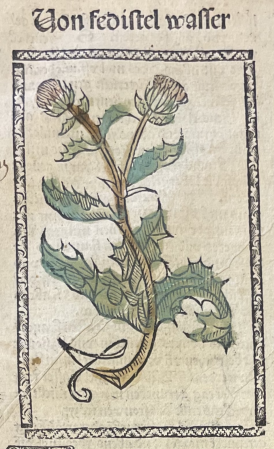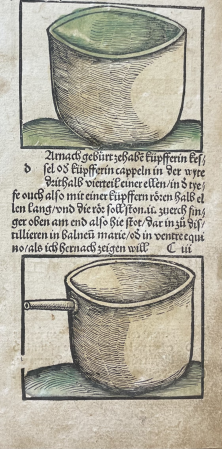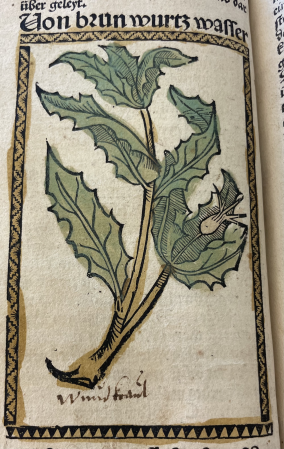Liber de Arte Distillandi de Simplicibus: Difference between revisions
| (47 intermediate revisions by the same user not shown) | |||
| Line 1: | Line 1: | ||
[[File:Front_Page.png|thumb|300px|right|Front Page of Book.]] | |||
== Overview == | == Overview == | ||
[https://franklin.library.upenn.edu/catalog/FRANKLIN_993909773503681 ''Liber de Arte Distillandi de Simplicibus''] is a book of distillation written in the German language by Hieronymus Brunschwig. It is additionally | [https://franklin.library.upenn.edu/catalog/FRANKLIN_993909773503681 ''Liber de Arte Distillandi de Simplicibus''] is a book of distillation written in the German language by Hieronymus Brunschwig. It is additionally referred to as ''Kleine Destillierbuch'', and was published on May 8, 1500. It is the first book written in the German language on the topic of distillation, making it very influential among early modern scholars. The book currently resides in the [https://www.library.upenn.edu/kislak University of Pennsylvania’s Kislak Center for Special Collections] after it was donated as a part of the [https://www.library.upenn.edu/collections/notable/edgar-fahs-smith-memorial Edgar Fahs Smith Memorial Collection.] | ||
== Historical Context == | == Historical Context == | ||
| Line 11: | Line 12: | ||
Hieronymus Brunschwig was a German surgeon, alchemist and botanist who lived from 1450-1512. Brunschwig established himself in Strasbourg, with his main work focusing on anatomy, the treatment of wounds, and pharmacy. | Hieronymus Brunschwig was a German surgeon, alchemist and botanist who lived from 1450-1512. Brunschwig established himself in Strasbourg, with his main work focusing on anatomy, the treatment of wounds, and pharmacy. | ||
Brunschwig’s work includes the creation of the first printed surgical treatise in the German language, containing the earliest detailed description of gunshot wounds. This work, titled ''Cirurgia'', became an important | Brunschwig’s work includes the creation of the first printed surgical treatise in the German language, containing the earliest detailed description of gunshot wounds. This work, titled ''Cirurgia'', became an important cultural and historical source for medicine and pharmacy. Due to its detailed illustrations, the book allowed for significant advancement in German surgery at the time.<ref> Hernigou, P. (2015). Medieval orthopaedic history in Germany: Hieronymus Brunschwig and Hans von Gersdorff. ''International Orthopaedics (SICOT)'' 39, 2081–2086. https://doi-org.proxy.library.upenn.edu/10.1007/s00264-015-2868-6 </ref> | ||
His later works include the earliest German work on distillation techniques, titled ''Liber de Arte Distillandi de Simplicibus''. This work had a major influence on medical chemistry and many subsequent publications were modeled after this work. Brunschwig’s work contains an extraordinary amount of technical detail, stressing the value of practical experience. His later works include more on distillation techniques, such as ''Liber de Arte Distillandi de Compositis'', published in 1512. <ref name="Taape"> Taape, T. (2014). Distilling Reliable Remedies: Hieronymus Brunschwig’s Liber de arte distillandi (1500) Between Alchemical Learning and Craft Practice. ''Ambix'', 61(3), 236–256. https://doi-org.proxy.library.upenn.edu/10.1179/0002698014Z.00000000060 </ref> | His later works include the earliest German work on distillation techniques, titled ''Liber de Arte Distillandi de Simplicibus''. This work had a major influence on medical chemistry and many subsequent publications were modeled after this work. Brunschwig’s work contains an extraordinary amount of technical detail, stressing the value of practical experience. His later works include more on distillation techniques, such as ''Liber de Arte Distillandi de Compositis'', published in 1512. <ref name="Taape"> Taape, T. (2014). Distilling Reliable Remedies: Hieronymus Brunschwig’s Liber de arte distillandi (1500) Between Alchemical Learning and Craft Practice. ''Ambix'', 61(3), 236–256. https://doi-org.proxy.library.upenn.edu/10.1179/0002698014Z.00000000060 </ref> | ||
| Line 21: | Line 22: | ||
Beginning in the 5th century, the city of Strasbourg was held by the Franks and governed by the Bishops of Strasbourg. After a power struggle between the city’s citizens and the bishops, Strasbourg became a free city within the Holy Roman Empire. The city of Strasbourg remained known as the <q>The Free City of Strasbourg</q> until the French Revolution (1789-1799) in which its status as a free city was revoked. <ref> Britannica, T. Editors of Encyclopaedia (2024, April 26). Strasbourg. ''Encyclopedia Britannica''. https://www.britannica.com/place/Strasbourg </ref> | Beginning in the 5th century, the city of Strasbourg was held by the Franks and governed by the Bishops of Strasbourg. After a power struggle between the city’s citizens and the bishops, Strasbourg became a free city within the Holy Roman Empire. The city of Strasbourg remained known as the <q>The Free City of Strasbourg</q> until the French Revolution (1789-1799) in which its status as a free city was revoked. <ref> Britannica, T. Editors of Encyclopaedia (2024, April 26). Strasbourg. ''Encyclopedia Britannica''. https://www.britannica.com/place/Strasbourg </ref> | ||
Throughout its history, Strasbourg has been governed by both France and Germany. In 1681, the city became French after it was seized by Louis XIV of France. The city later became German in 1871 after the Franco-Prussian War. At the end of World War I (1918), the city was reverted to France until it was seized by Germany in 1940 (during World War II). In November 1944, the city was liberated by the French and once again became a French city. <ref> | Throughout its history, Strasbourg has been governed by both France and Germany. In 1681, the city became French after it was seized by Louis XIV of France. The city later became German in 1871 after the Franco-Prussian War. At the end of World War I (1918), the city was reverted to France until it was seized by Germany in 1940 (during World War II). In November 1944, the city was liberated by the French and once again became a French city. <ref> Archives de la Ville et de L’Eurométropole de Strasbourg. (n.d.). ''Les Temps de L’Histoire de Strasbourg''. Strasbourg.eu. https://archives.strasbourg.eu/n/les-temps-de-l-histoire-de-strasbourg/n:106#p678 </ref> | ||
==== Printing Industry ==== | ==== Printing Industry ==== | ||
| Line 29: | Line 30: | ||
== Content == | == Content == | ||
Written by Hieronymus Brunschwig, ''Liber de Arte Distillandi de Simplicibus'' was the first book to be written in German on the subject of distillation. It was additionally the first book published in the English vernacular on the subject of chemistry. Despite its Latin title, the book is written entirely in German and contains very detailed illustrations of stills (apparatus to distill liquid), plants and animals. | |||
During the early modern period, distilled waters were used as medical remedies. ''Liber de Arte Distillandi de Simplicibus'' was a manual on how to distill these medicinal waters by combining technical instructions with traditional practices. The book is split into three parts, each detailing a different aspect of distillation for medicinal treatment. The first section of the book details the methods and apparatus of distillation. This was mainly based on Brunschwig’s own observations and includes illustrations of the tools and methods needed. The second section is a compendium of plants whose products can be distilled. This section includes a discussion of these plants and their attributes, containing many illustrations that detail the appearance of these plants. The third section is an index of ailments, listing the distilled plant remedies for each. This final section references the plants described in the second section of the book, describing the ailment each plant may be used to treat. <ref name="Taape"/> | |||
[[File:Example_Page1.png|thumb|300px|right|Example of Page Showing Illustrations and Text. Shows Folio Marking.]] | |||
== Materials Analysis == | == Materials Analysis == | ||
=== Substrate === | === Substrate === | ||
Published in 1500, ''Liber de Arte Distillandi de Simplicibus'' is a codex with folio formatting. It is a folio in 8s with a leaf size of 276 x 184 mm. The pages are made of paper, which can be identified through the chain lines of the paper. The copy located at Penn Libraries has many leaves that are torn and mended, and additionally contains indications of being rebound. Each page has two columns with 47 lines of text. The text is printed using movable type printing. | |||
The copy located at Penn Libraries is bound in modern green paper boards with fore-edge flaps. The front 2 pages are made from a different paper as the rest of the book, pointing to the copy being rebound. The book has a paper spine labeled <q>Brunschwig. Kleines Destillierbuch Strassburg 1500,</q> and contains a paper slip with the bookseller's printed description of this copy attached to front pastedown. | |||
=== Navigation === | === Navigation === | ||
The pages of ''Liber de Arte Distillandi de Simplicibus'' contain signatures on the bottom of pages to identify folios. Each page has a number at the top right of the page, along with titles on the top of each page. This allows readers to navigate the different sections of the book on specific information on plants and distillation processes. The pages additionally contain signatures on the right pages beneath the text to identify folios. | |||
=== Illustrations === | === Illustrations === | ||
Along with printed text, many pages contain illustrations of stills (apparatus to distill liquid), plants and animals. These illustrations are relief prints using woodcuts. As the book contains many illustrations, woodcuts were an efficient method of printing as they could be set with the movable type. These woodcut illustrations were used with the relief printing. Many of the woodcuts used in ''Liber de Arte Distillandi de Simplicibus'' were previously used in Johann Grüninger’s press in earlier books, or are copies of these previously used woodcuts. Most illustrations have been hand colored with green, yellow, red and brown ink. The illustrations have different borders that were used throughout the book, with individual border pieces set with the different illustrations. | |||
An additional copy of ''Liber de Arte Distillandi de Simplicibus'' residing in the [https://www.loc.gov/resource/rbc0001.2017rosen0202/?sp=279&r=-0.358,-0.087,1.652,1.442,0 Library of Congress] does not appear to have any illustrations colored. This suggests these illustrations may have been hand colored after the initial publication of the book, although it is unknown when and who colored them. <ref> BRUNSCHWIG, HIERONYMUS. [Kleines Destillierbuch (German)]. Liber de arte distillandi, de simplicibus. Das buch der rechten kunst zu distilieren die eintzigen ding. Strassburg: Johann (Reinhard) Grüninger, 8 May 1500. Christie’s. (n.d.-b). https://www.christies.com/en/lot/lot-2534322 </ref> | |||
<gallery mode="packed" perrow=4 heights=300px> | |||
File:Illustration_1.png|Illustration of Plant | |||
File:Illustration_2.png|Illustration of Distillation Process | |||
File:Illustration_3.png|Illustration of Plant with Annotation | |||
{...} | |||
</gallery> | |||
[[File:Marginalia1.png|thumb|300px|right|Example of Marginalia.]] | |||
=== Annotations === | === Annotations === | ||
The copy of ''Liber de Arte Distillandi de Simplicibus'' residing in the Penn Libraries contains occasional contemporary annotations throughout the book. These annotations are done in brown ink on illustrations of plants and descriptions of plants and remedies. | |||
== Circulation and Provenance == | |||
=== Circulation === | |||
Following its initial publication, ''Liber de Arte Distillandi de Simplicibus'' was extremely successful commercially. The book was published in 16 different editions from 1500 to 1568, and was additionally found in reprints of ''Medicinarius'', one of Hieronymus Brunschwig’s later works, starting from 1505. | |||
''Liber de Arte Distillandi de Simplicibus'' was one of the first books on the natural sciences, and specifically chemistry, that was translated into English. The book was ultimately translated into three different languages following its initial publication in German. In 1517 the book was translated into Dutch by Thomas van der Noot in Brussels, in 1527 it was translated into English by Lawrence Andrew in London, and in 1559 it was translated into Czech by Jan Günther in Olmütz. <ref name="Taape"/> | |||
=== Provenance === | |||
''Liber de Arte Distillandi de Simplicibus'' is currently a part of Edgar Fahs Smith Memorial Collection at the University of Pennsylvania. The Edgar Fahs Smith Memorial Collection is a collection of early and modern texts on chemistry, alchemy, early medicine and pharmacology, dyeing, metallurgy, mineralogy, and pyrotechnics. It also contains works on the biographies of chemists, the chemical industry, and the history of chemical education. | |||
The collection was formed by [https://en.wikipedia.org/wiki/Edgar_Fahs_Smith Edgar Fahs Smith] (1854-1928), a professor of chemistry and provost of the University of Pennsylvania. Following his death, the collection was endowed by his widow and has continued to grow. <ref> University of Pennsylvania. (n.d.). ''Edgar Fahs Smith Memorial Collection''. Penn Libraries. https://www.library.upenn.edu/collections/notable/edgar-fahs-smith-memorial </ref> | |||
== Significance == | |||
The work ''Liber de Arte Distillandi de Simplicibus'' was very influential and had much commercial success. The book was published in 16 different editions from 1500 to 1568 and influenced many later works on distillation. With many different translations, the book’s influence on the natural sciences and distillation techniques extended beyond Germany. The book was the first book to be written in German on the subject of distillation, sparking following research and publication of similar books. Much of the information in ''Liber de Arte Distillandi de Simplicibus'' was additionally different from other books on the subject, as it was based on Hieronymus Brunschwig’s own observations, as well as manuscripts from the 15th century. Brunschwig’s work is considered an important link between information from the Middle Ages and the modern age. With its detailed illustrations, the book was widely used for many years and considered an authoritative text throughout the 16th century. | |||
== Notes == | == Notes == | ||
Latest revision as of 05:14, 12 May 2024
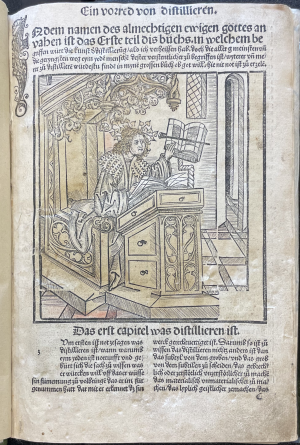
Overview
Liber de Arte Distillandi de Simplicibus is a book of distillation written in the German language by Hieronymus Brunschwig. It is additionally referred to as Kleine Destillierbuch, and was published on May 8, 1500. It is the first book written in the German language on the topic of distillation, making it very influential among early modern scholars. The book currently resides in the University of Pennsylvania’s Kislak Center for Special Collections after it was donated as a part of the Edgar Fahs Smith Memorial Collection.
Historical Context
Johann Grüninger
Liber de Arte Distillandi de Simplicibus was published by Johann Grüninger, a German printer who resided in Strasbourg. Grüninger lived from 1455–1533 and was one of the most prolific printers of Strasbourg. Many of Grüninger’s publications were Catholic, however he additionally printed works ranging from humanist to scientific texts. Johann Grüninger established himself in Strasbourg during a period of great development in printing. In this period Strasbourg became a famous center for scientific studies and printing, additionally developing a reputation for the incredible woodcuts used in the printing.[1]
Hieronymus Brunschwig
Hieronymus Brunschwig was a German surgeon, alchemist and botanist who lived from 1450-1512. Brunschwig established himself in Strasbourg, with his main work focusing on anatomy, the treatment of wounds, and pharmacy.
Brunschwig’s work includes the creation of the first printed surgical treatise in the German language, containing the earliest detailed description of gunshot wounds. This work, titled Cirurgia, became an important cultural and historical source for medicine and pharmacy. Due to its detailed illustrations, the book allowed for significant advancement in German surgery at the time.[2]
His later works include the earliest German work on distillation techniques, titled Liber de Arte Distillandi de Simplicibus. This work had a major influence on medical chemistry and many subsequent publications were modeled after this work. Brunschwig’s work contains an extraordinary amount of technical detail, stressing the value of practical experience. His later works include more on distillation techniques, such as Liber de Arte Distillandi de Compositis, published in 1512. [3]
Strasbourg
Occupation
The modern city of Strasbourg is located in France near the German border. Today, Strasbourg is seen as a symbol of Franco-German settlement and European integration.
Beginning in the 5th century, the city of Strasbourg was held by the Franks and governed by the Bishops of Strasbourg. After a power struggle between the city’s citizens and the bishops, Strasbourg became a free city within the Holy Roman Empire. The city of Strasbourg remained known as the The Free City of Strasbourg
until the French Revolution (1789-1799) in which its status as a free city was revoked. [4]
Throughout its history, Strasbourg has been governed by both France and Germany. In 1681, the city became French after it was seized by Louis XIV of France. The city later became German in 1871 after the Franco-Prussian War. At the end of World War I (1918), the city was reverted to France until it was seized by Germany in 1940 (during World War II). In November 1944, the city was liberated by the French and once again became a French city. [5]
Printing Industry
The city holds a rich history with the development and use of printing technologies. One of the most notable occupants of the Strasbourg was Johannes Gutenberg, inventor of the movable-type printing press. Gutenberg spent several years experimenting at Strasbourg in the 1430s-1440s.
Strasbourg’s output of printed works greatly expanded around 1500 and the early 16th century. Printers in this region, such as Johann Grüninger, began to develop a reputation for Strasbourg, making the city known for its output of illustrated works. In the early 16th century, Germany produced more incunabula illustrated with woodcuts than anywhere else. This led to the development of the woodcut as a major art form. [1]
Content
Written by Hieronymus Brunschwig, Liber de Arte Distillandi de Simplicibus was the first book to be written in German on the subject of distillation. It was additionally the first book published in the English vernacular on the subject of chemistry. Despite its Latin title, the book is written entirely in German and contains very detailed illustrations of stills (apparatus to distill liquid), plants and animals.
During the early modern period, distilled waters were used as medical remedies. Liber de Arte Distillandi de Simplicibus was a manual on how to distill these medicinal waters by combining technical instructions with traditional practices. The book is split into three parts, each detailing a different aspect of distillation for medicinal treatment. The first section of the book details the methods and apparatus of distillation. This was mainly based on Brunschwig’s own observations and includes illustrations of the tools and methods needed. The second section is a compendium of plants whose products can be distilled. This section includes a discussion of these plants and their attributes, containing many illustrations that detail the appearance of these plants. The third section is an index of ailments, listing the distilled plant remedies for each. This final section references the plants described in the second section of the book, describing the ailment each plant may be used to treat. [3]
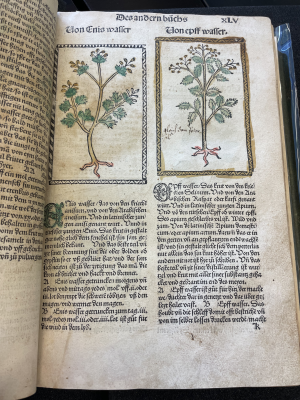
Materials Analysis
Substrate
Published in 1500, Liber de Arte Distillandi de Simplicibus is a codex with folio formatting. It is a folio in 8s with a leaf size of 276 x 184 mm. The pages are made of paper, which can be identified through the chain lines of the paper. The copy located at Penn Libraries has many leaves that are torn and mended, and additionally contains indications of being rebound. Each page has two columns with 47 lines of text. The text is printed using movable type printing.
The copy located at Penn Libraries is bound in modern green paper boards with fore-edge flaps. The front 2 pages are made from a different paper as the rest of the book, pointing to the copy being rebound. The book has a paper spine labeled Brunschwig. Kleines Destillierbuch Strassburg 1500,
and contains a paper slip with the bookseller's printed description of this copy attached to front pastedown.
The pages of Liber de Arte Distillandi de Simplicibus contain signatures on the bottom of pages to identify folios. Each page has a number at the top right of the page, along with titles on the top of each page. This allows readers to navigate the different sections of the book on specific information on plants and distillation processes. The pages additionally contain signatures on the right pages beneath the text to identify folios.
Illustrations
Along with printed text, many pages contain illustrations of stills (apparatus to distill liquid), plants and animals. These illustrations are relief prints using woodcuts. As the book contains many illustrations, woodcuts were an efficient method of printing as they could be set with the movable type. These woodcut illustrations were used with the relief printing. Many of the woodcuts used in Liber de Arte Distillandi de Simplicibus were previously used in Johann Grüninger’s press in earlier books, or are copies of these previously used woodcuts. Most illustrations have been hand colored with green, yellow, red and brown ink. The illustrations have different borders that were used throughout the book, with individual border pieces set with the different illustrations.
An additional copy of Liber de Arte Distillandi de Simplicibus residing in the Library of Congress does not appear to have any illustrations colored. This suggests these illustrations may have been hand colored after the initial publication of the book, although it is unknown when and who colored them. [6]
-
Illustration of Plant
-
Illustration of Distillation Process
-
Illustration of Plant with Annotation

Annotations
The copy of Liber de Arte Distillandi de Simplicibus residing in the Penn Libraries contains occasional contemporary annotations throughout the book. These annotations are done in brown ink on illustrations of plants and descriptions of plants and remedies.
Circulation and Provenance
Circulation
Following its initial publication, Liber de Arte Distillandi de Simplicibus was extremely successful commercially. The book was published in 16 different editions from 1500 to 1568, and was additionally found in reprints of Medicinarius, one of Hieronymus Brunschwig’s later works, starting from 1505.
Liber de Arte Distillandi de Simplicibus was one of the first books on the natural sciences, and specifically chemistry, that was translated into English. The book was ultimately translated into three different languages following its initial publication in German. In 1517 the book was translated into Dutch by Thomas van der Noot in Brussels, in 1527 it was translated into English by Lawrence Andrew in London, and in 1559 it was translated into Czech by Jan Günther in Olmütz. [3]
Provenance
Liber de Arte Distillandi de Simplicibus is currently a part of Edgar Fahs Smith Memorial Collection at the University of Pennsylvania. The Edgar Fahs Smith Memorial Collection is a collection of early and modern texts on chemistry, alchemy, early medicine and pharmacology, dyeing, metallurgy, mineralogy, and pyrotechnics. It also contains works on the biographies of chemists, the chemical industry, and the history of chemical education.
The collection was formed by Edgar Fahs Smith (1854-1928), a professor of chemistry and provost of the University of Pennsylvania. Following his death, the collection was endowed by his widow and has continued to grow. [7]
Significance
The work Liber de Arte Distillandi de Simplicibus was very influential and had much commercial success. The book was published in 16 different editions from 1500 to 1568 and influenced many later works on distillation. With many different translations, the book’s influence on the natural sciences and distillation techniques extended beyond Germany. The book was the first book to be written in German on the subject of distillation, sparking following research and publication of similar books. Much of the information in Liber de Arte Distillandi de Simplicibus was additionally different from other books on the subject, as it was based on Hieronymus Brunschwig’s own observations, as well as manuscripts from the 15th century. Brunschwig’s work is considered an important link between information from the Middle Ages and the modern age. With its detailed illustrations, the book was widely used for many years and considered an authoritative text throughout the 16th century.
Notes
- ↑ 1.0 1.1 Flood, J. L. (2010). The History of the Book in Germany. In The Oxford Companion to the Book. essay, Oxford University Press. Retrieved from https://www-oxfordreference-com.proxy.library.upenn.edu/display/10.1093/acref/9780198606536.001.0001/acref-9780198606536-e-0026#acref-9780198606536-div1-1798.
- ↑ Hernigou, P. (2015). Medieval orthopaedic history in Germany: Hieronymus Brunschwig and Hans von Gersdorff. International Orthopaedics (SICOT) 39, 2081–2086. https://doi-org.proxy.library.upenn.edu/10.1007/s00264-015-2868-6
- ↑ 3.0 3.1 3.2 Taape, T. (2014). Distilling Reliable Remedies: Hieronymus Brunschwig’s Liber de arte distillandi (1500) Between Alchemical Learning and Craft Practice. Ambix, 61(3), 236–256. https://doi-org.proxy.library.upenn.edu/10.1179/0002698014Z.00000000060
- ↑ Britannica, T. Editors of Encyclopaedia (2024, April 26). Strasbourg. Encyclopedia Britannica. https://www.britannica.com/place/Strasbourg
- ↑ Archives de la Ville et de L’Eurométropole de Strasbourg. (n.d.). Les Temps de L’Histoire de Strasbourg. Strasbourg.eu. https://archives.strasbourg.eu/n/les-temps-de-l-histoire-de-strasbourg/n:106#p678
- ↑ BRUNSCHWIG, HIERONYMUS. [Kleines Destillierbuch (German)]. Liber de arte distillandi, de simplicibus. Das buch der rechten kunst zu distilieren die eintzigen ding. Strassburg: Johann (Reinhard) Grüninger, 8 May 1500. Christie’s. (n.d.-b). https://www.christies.com/en/lot/lot-2534322
- ↑ University of Pennsylvania. (n.d.). Edgar Fahs Smith Memorial Collection. Penn Libraries. https://www.library.upenn.edu/collections/notable/edgar-fahs-smith-memorial
